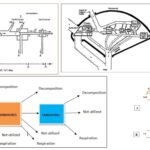AS and A Level Biology 83 Views 1 Answers
Sourav PanLv 9October 28, 2024
Relate the structure of haemoglobin to its function, including the importance of iron in the haem group
Relate the structure of haemoglobin to its function, including the importance of iron in the haem group
Please login to save the post
Please login to submit an answer.
Sourav PanLv 9May 15, 2025
Hemoglobin is a globular protein that plays a crucial role in transporting oxygen in the blood. Its structure is intricately related to its function, particularly through the role of the heme group and the iron it contains. Here’s how the structure of hemoglobin relates to its function:
Structure of Hemoglobin:
- Quaternary Structure: Hemoglobin consists of four polypeptide chains (two alpha and two beta subunits), which form a tetramer. This quaternary structure allows for cooperative binding of oxygen, enhancing its efficiency in oxygen transport.
- Heme Groups: Each of the four subunits contains a heme group, which is a prosthetic group consisting of a porphyrin ring and an iron (Fe²⁺) atom at its center. This heme group is crucial for oxygen binding.
- Flexible Conformation: Hemoglobin undergoes conformational changes as it binds to oxygen. In the deoxy (T-state) form, the subunits are in a tense configuration, and when oxygen binds, it triggers a shift to the relaxed (R-state) configuration, which facilitates further oxygen binding.
Function of Hemoglobin:
- Oxygen Binding and Release:
- Iron’s Role: The iron atom in the heme group has a high affinity for oxygen. When oxygen binds to the iron (Fe²⁺), it causes the heme to change shape, pulling on the histidine residue that holds it in place. This structural change is transmitted through the protein, leading to the stabilization of the R-state and increasing the affinity for additional oxygen molecules.
- Cooperative Binding: This mechanism of cooperative binding means that once one heme group binds to oxygen, the remaining heme groups are more likely to bind oxygen as well. This allows hemoglobin to efficiently pick up oxygen in the lungs and release it in tissues where it is needed.
- Transport of Carbon Dioxide: Hemoglobin also aids in transporting carbon dioxide (CO₂) from tissues back to the lungs. CO₂ can bind to hemoglobin in a different manner, leading to a release of oxygen (Bohr effect). The conformation change associated with CO₂ binding reduces hemoglobin’s affinity for oxygen, facilitating oxygen release in areas of high CO₂ concentration.
- Buffering Capacity: Hemoglobin helps maintain blood pH by binding to hydrogen ions (H⁺) produced during metabolism. This buffering capacity is vital for homeostasis.
Importance of Iron:
- Essential for Oxygen Binding: The presence of iron in the heme group is critical because only the ferrous (Fe²⁺) state can bind oxygen. If the iron were in the ferric (Fe³⁺) state, hemoglobin would be unable to bind oxygen effectively, leading to insufficient oxygen transport.
- Prevention of Oxidative Damage: Iron is tightly regulated in the body to prevent oxidative damage. The heme group protects iron from oxidation, maintaining its ability to reversibly bind oxygen.
0
0 likes
- Share on Facebook
- Share on Twitter
- Share on LinkedIn
0 found this helpful out of 0 votes
Helpful: 0%
Helpful: 0%
Was this page helpful?




